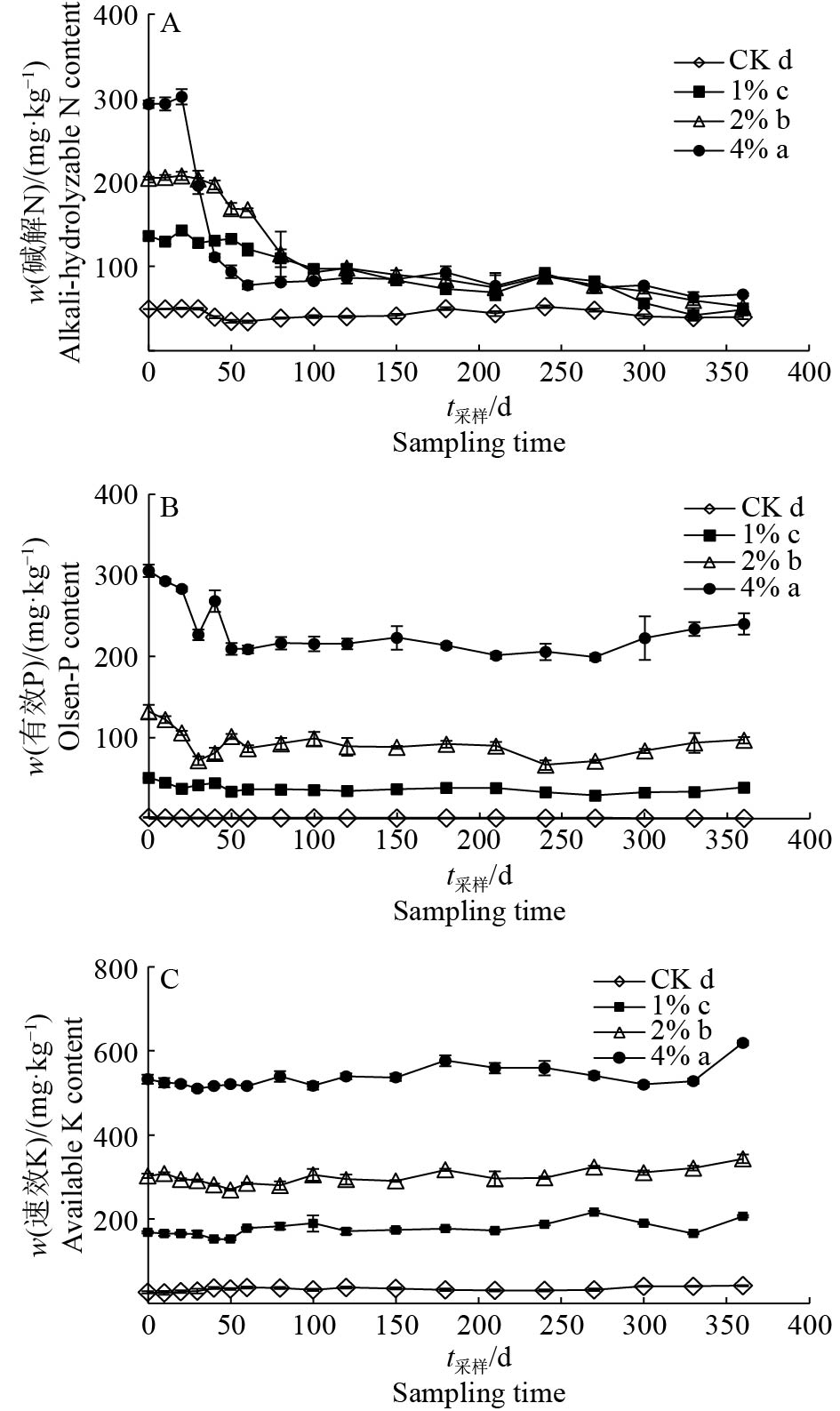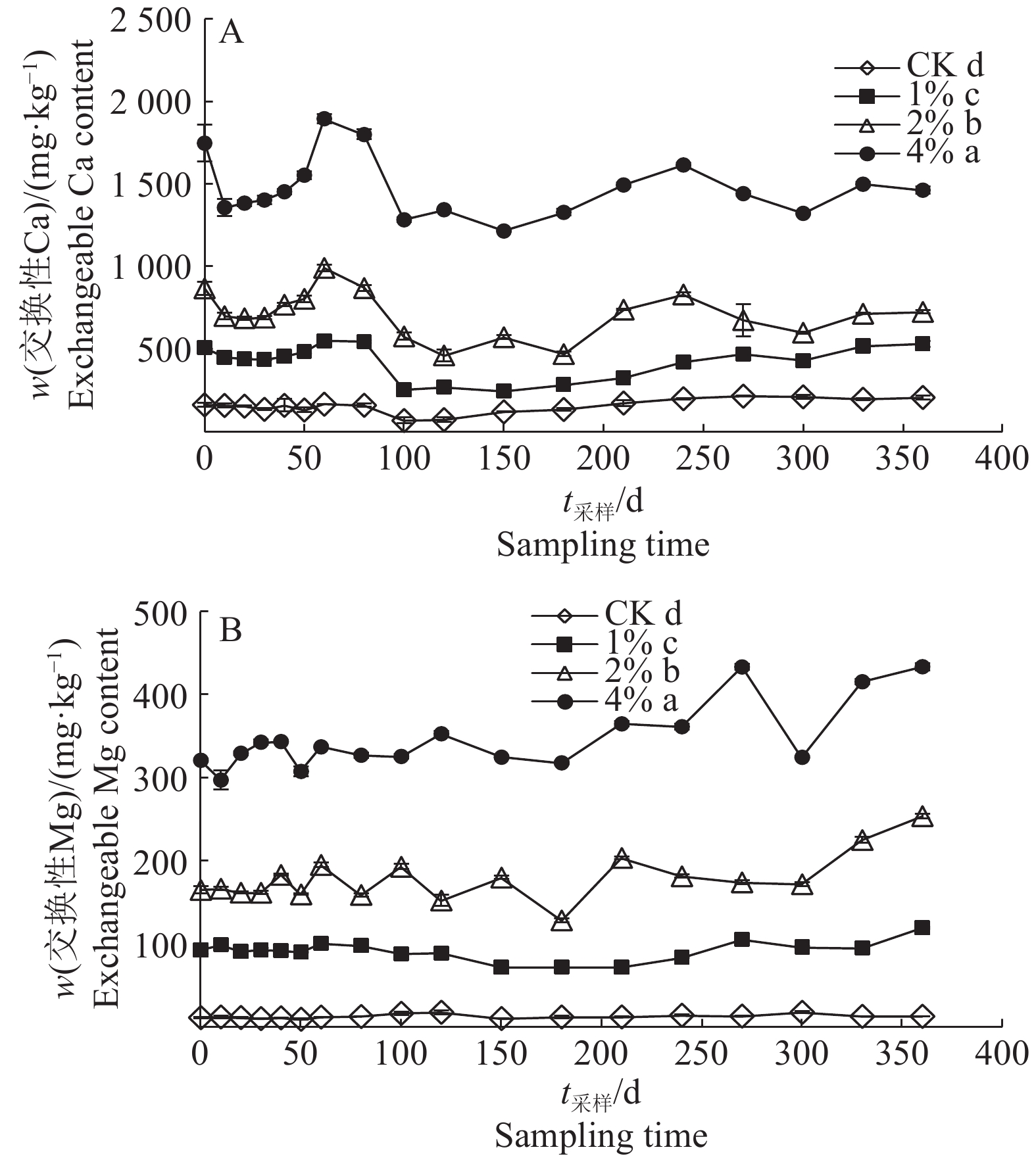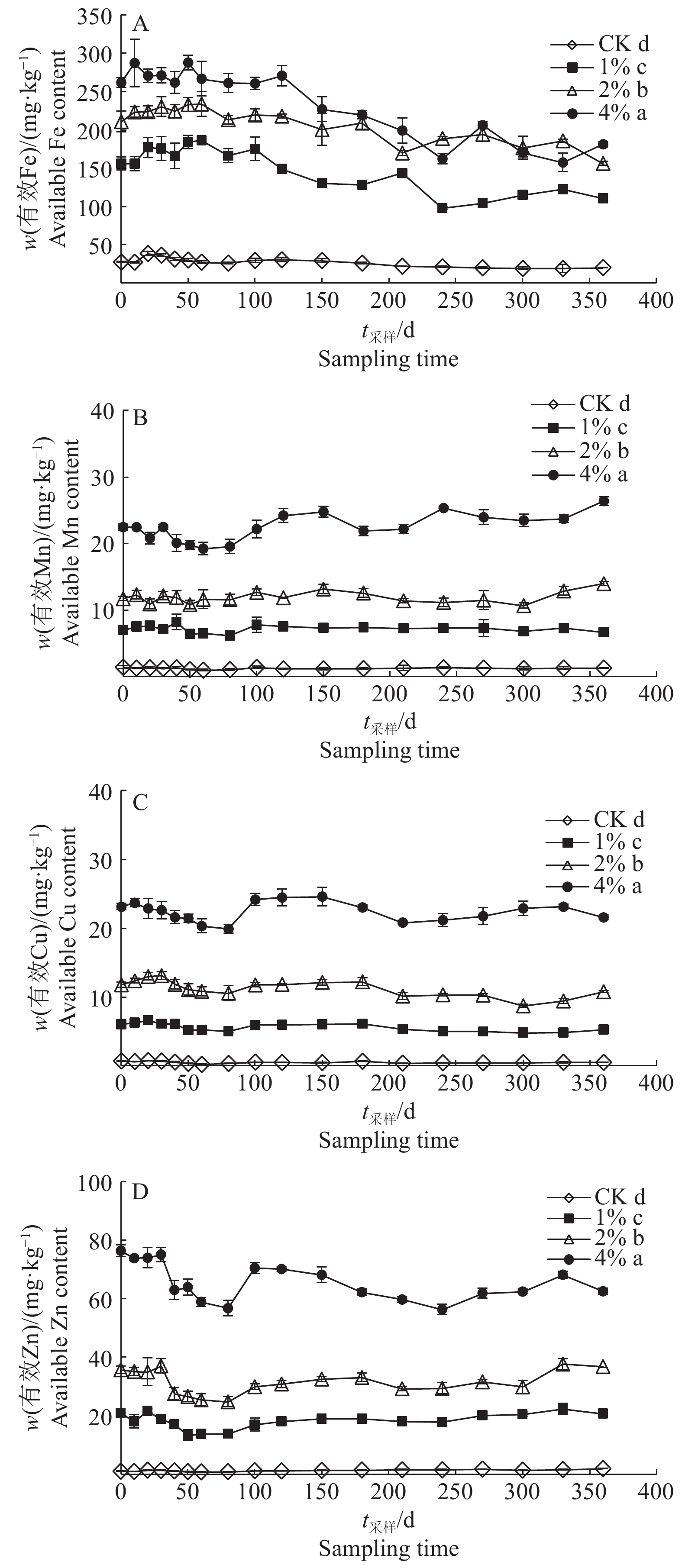Dynamic changes of nutrient contents in orchard soil after pig manure application
-
摘要:目的
研究猪粪施入土壤后,土壤中各养分含量的动态变化,为荔枝生产合理施用粪肥提供参考。
方法在荔枝果园土壤中添加不同用量猪粪(w为0、1%、2%和4%)进行培养试验,探讨土壤中的大、中和微量元素养分含量在360 d的动态变化。
结果即使土壤中有效N、P、K、Ca和Mg含量缺乏,Mn、Cu和Zn含量中等,以1%用量施用猪粪后,除交换性Ca和Mg含量达中等水平外,其他养分可立刻达到丰富水平。猪粪用量越高,土壤碱解N维持在丰富水平的时间越短且降幅越大,但有效P、速效K、交换性Ca、Mg以及有效Fe、Mn、Cu、Zn含量显著提高(P<0.05),而且除速效K和有效Fe外的其他养分含量波动越大,供应稳定性越差。
结论猪粪是良好的作物养分来源,但荔枝生产上用量不宜超过1%,即15 t·hm–2,配合施用的各种化肥(如N肥和K肥)也应相应减少或甚至不施P肥和Fe、Mn、Cu、Zn等微肥。
Abstract:ObjectiveDynamic changes of nutrient contents in soil applied with pig manure were studied with the aim to offer guideline for reasonable manure application in litchi production.
MethodThe variations of macro-, secondary and micro-nutrients in soils applied with different contents (w=0, 1%, 2% and 4%) of pig manure were investigated during 360 days of incubation test.
ResultIn soil deficient of available N, P, K, Ca, Mg and medium of available Mn, Cu and Zn, after pig manure was applied at the content of 1%, the contents of all soil nutrients immediately reached abundant levels, except that exchangeable Ca and Mg contents reached medium levels. As the manure application rate increased, soil alkali-hydrolyzable N maintained at rich level with shorter duration and then decreased more sharply, while soil available P, K, Ca, Mg, Fe, Mn, Cu and Zn contents significantly increased (P<0.05). Moreover, soil nutrient (except available K and Fe) contents had larger fluctuations, leading to lower stability of soil nutrient supply.
ConclusionPig manure is a quality nutrient source for crop and is recommended to be applied at the rate of no more than 1%, namely 15 t·hm–1 in litchi production. Simultaneously, the application rates of inorganic N and K fertilizers should be reduced, and some other inorganic fertilizers such as P, Fe, Mn, Cu and Zn should be withdrawn.
-
Keywords:
- soil nutrient /
- animal manure /
- organic fertilizer /
- litchi orchard /
- nutrient management
-
-
图 1 不同用量猪粪处理土壤中的大量元素养分含量动态变化
以360 d培养过程的平均值进行差异显著性分析,图例后面的不同小写字母表示处理间差异显著(P<0.05,Duncan’s法)
Figure 1. Dynamic changes of macro-nutrient contents in soils amended with different doses of pig manure
Means of the 360-day culture process were used for testing significant differences. Different lowercase letters following the treatment legends refer to significant differences (P<0.05,Duncan’s method)
图 2 不同用量猪粪处理土壤中的中量元素养分含量动态变化
以360 d培养过程的平均值进行差异显著性分析,图例后面的不同小写字母表示处理间差异显著(P<0.05,Duncan’s法)
Figure 2. Dynamic changes of secondary nutrient contents in soils amended with different doses of pig manure
Means of the 360-day culture process were used for testing significant differences. Different lowercase letters following the treatment legends refer to significant differences (P<0.05,Duncan’s method)
图 3 不同用量猪粪处理土壤中的微量元素含量动态变化
以360 d培养过程的平均值进行差异显著性分析,图例后面的不同小写字母表示处理间差异显著(P<0.05,Duncan’s法)
Figure 3. Dynamic changes of micro-nutrient contents in soils amended with different doses of pig manure
Means of the 360-day culture process were used for testing significant differences. Different lowercase letters following the treatment legends refer to significant differences (P<0.05,Duncan’s method)
表 1 供试土壤和猪粪的理化性质
Table 1 Physicochemical properties of soil and pig manure
项目
ItempH w (有机质)/
(g·kg–1)
Organic matterw (全量养分)/(g·kg–1)
Total nutrient contentw (全量养分)/(mg·kg–1)
Total nutrient contentN P K Ca Mg Fe Mn Cu Zn 土壤
Soil4.2±0.2 14.1±0.2 74.6±1.4 84.0±3.4 30.8±0.5 50.9±5.9 猪粪
Pig manure6.8±0.0 552.3±1.9 38.5±0.4 14.9±0.3 23.2±0.6 13.2±0.7 5.7±0.0 3.3±0.0 711.1±4.8 791.4±0.2 2 954.4±35.0 -
[1] 吴大伟, 李亚学, 吴萍, 等. 规模化猪场育肥猪饲料、猪肉及粪便中重金属含量调查[J]. 畜牧与兽医, 2012, 44(4): 38-40. [2] 田佳, 刘国华, 蔡辉益, 等. 畜禽微量元素研究与应用的新进展[J]. 中国家禽, 2016, 38(2): 37-41. [3] 姚丽贤, 李国良, 党志. 集约化养殖禽畜粪中主要化学物质调查[J]. 应用生态学报, 2006, 17(10): 1989-1992. doi: 10.3321/j.issn:1001-9332.2006.10.041 [4] 商和平, 李洋, 张涛, 等. 畜禽粪便有机肥中Cu、Zn在不同农田土壤中的形态归趋和有效性动态变化[J]. 环境科学, 2015, 36(1): 314-324. [5] 赵明, 蔡葵, 赵征宇, 等. 畜禽粪肥对土壤有效铜锌铁锰含量的影响[J]. 土壤通报, 2007, 38(1): 93-96. doi: 10.3321/j.issn:0564-3945.2007.01.022 [6] 姚丽贤, 李国良, 何兆桓, 等. 施用禽畜粪对两种土壤As、Cu和Zn有效性的影响[J]. 土壤学报, 2009, 46(1): 127-135. doi: 10.3321/j.issn:0564-3929.2009.01.018 [7] 莫淑勋, 钱菊芳, 钱承梁. 猪粪等有机肥料中磷素养分循环再利用的研究[J]. 土壤学报, 1991, 28(3): 309-316. [8] 赵明, 陈雪辉, 赵征宇, 等. 鸡粪等有机肥料的养分释放及对土壤有效铜、锌、铁、锰含量的影响[J]. 中国生态农业学报, 2007, 15(2): 47-50. [9] 余华荣, 周灿芳, 万忠, 等. 2011年广东荔枝产业发展现状分析[J]. 广东农业科学, 2012, 39(4): 16-17. doi: 10.3969/j.issn.1004-874X.2012.04.006 [10] 姚丽贤. 我国荔枝养分管理技术应用与需求调研报告[J]. 荔枝科技通讯, 2009(3): 49-50. [11] 陈东义, 崔辉, 勾现清. 蔬菜无公害生产测土配方施肥技术[J]. 作物杂志, 2008, 46(3): 98-100. doi: 10.3969/j.issn.1001-7283.2008.03.036 [12] 石慧, 白翠华, 周昌敏, 等. 施用猪粪土壤中抗生素的降解、植物有效性及土壤酶活性变化[J]. 农业环境科学学报, 2017, 36(10): 2039-2047. doi: 10.11654/jaes.2017-0358 [13] 李建国. 荔枝学[M]. 北京: 中国农业出版社, 2008: 412-413. [14] 鲁如坤. 土壤农化分析方法[M]. 北京: 中国农业科学技术出版社, 2000: 12-449. [15] 张桂玲. 秸秆和生草覆盖对桃园土壤养分含量、微生物数量及土壤酶活性的影响[J]. 植物生态学报, 2011, 35(12): 1236-1244. [16] 杨丽娟, 李天来, 付时丰, 等. 长期施肥对菜田土壤微量元素有效性的影响[J]. 植物营养与肥料学报, 2006, 12(4): 549-553. doi: 10.3321/j.issn:1008-505X.2006.04.015 [17] 郭微, 戴九兰, 王仁卿. 溶解性有机质影响土壤吸附重金属的研究进展[J]. 土壤通报, 2012, 43(3): 761-768. [18] LI Y X, LI W, WU J, et al. Contribution of additives Cu to its accumulation in pig feces: Study in Beijing and Fuxin of China[J]. Soil Sci Soc Am J, 2007, 19(5): 610-615.
[19] 蒙洪娇, 姜海龙, 朱世馨, 等. 饲料中微量元素对禽畜组织及环境的影响[J]. 黑龙江畜牧兽医, 2017, 1(2): 69-72. [20] KEMPER N. Veterinary antibiotics in the aquatic and terrestrial environment[J]. Ecol Indic, 2008, 8(1): 1-13.
[21] 金明. 规模化畜牧生产对环境的污染及防治措施[J]. 家畜生态学报, 2007, 28(2): 5-8. doi: 10.3969/j.issn.1673-1182.2007.02.002 [22] 广东省土壤普查办公室. 广东土壤[M]. 北京: 科学出版社, 1993. [23] 王昌全, 李冰, 龚斌, 等. 西昌市土壤Fe、Mn、Cu、Zn有效性评价及其影响因素分析[J]. 土壤通报, 2010, 41(2): 447-451. [24] 刘庆, 夏江宝, 陆兆华. 黄河三角洲不同土地利用土壤有效态微量元素提取[J]. 水土保持学报, 2012, 26(1): 124-135. [25] 李国良, 姚丽贤, 何兆桓, 等. 广东省荔枝园土壤养分肥力现状评价[J]. 土壤通报, 2009, 40(4): 800-804. [26] 蔡建兴. 漳州市荔枝园土壤肥力状况调查与分析[J]. 中国南方果树, 2013, 42(2): 76-78. [27] 覃群明. 玉林市荔枝园土壤养分肥力状况分析评价[J]. 中国南方果树, 2014, 43(2): 82-85. [28] 魏志远, 孙娟, 李松刚, 等. 海南中西部荔枝园土壤肥力的灰色关联度评价[J]. 热带作物学报, 2013, 34(10): 1883-1887. doi: 10.3969/j.issn.1000-2561.2013.10.006 [29] 姚丽贤, 周昌敏, 何兆恒, 等. 荔枝年度枝梢和花果发育养分需求特征[J]. 植物营养与肥料学报, 2017, 23(14): 1128-1134. [30] 薛石龙, 丁效东, 廖新荣, 等. 有机肥施用对珠三角菜地土壤磷污染风险的初步研究[J]. 生态环境学报, 2013, 22(8): 1428-1431. doi: 10.3969/j.issn.1674-5906.2013.08.026 [31] 孔庆波. 基于GIS我国农田土壤磷素管理及磷肥需求预测研究[D]. 北京: 中国农业科学院, 2008. [32] 张淑香, 张文菊, 沈仁芳, 等. 我国典型农田长期施肥土壤肥力变化与研究展望[J]. 植物营养与肥料学报, 2015, 21(6): 1389-1393. [33] 朱晓晖. 施用有机肥对土壤磷组分和农田磷流失的影响[D]. 北京: 中国农业科学院, 2011. [34] 曹志洪, 林先贵, 杨林章, 等. 论“稻田圈”在保护城乡生态环境中的功能Ⅰ:稻田土壤磷素径流迁移流失的特征[J]. 土壤学报, 2005, 42(5): 799-804. doi: 10.3321/j.issn:0564-3929.2005.05.013 [35] PAN M, CHU L M. Fate of antibiotics in soil and their uptake by edible crops[J]. Sci Total Environ, 2017, 599/600: 500-512. doi: 10.1016/j.scitotenv.2017.04.214
[36] BOXALL A, JOHNSON P, SMITH E, et al. Uptake of veterinary medicines from soils into plants[J]. J Agric Food Chem, 2006, 54(6): 2288-2297. doi: 10.1021/jf053041t




 下载:
下载:


